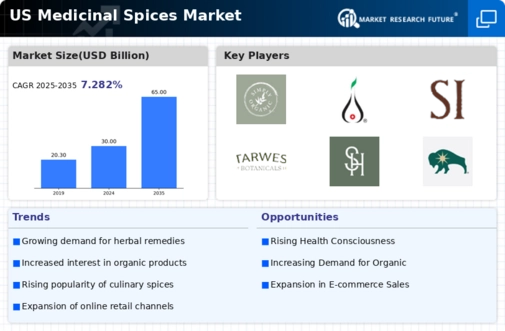The US Medicinal Spices Market has witnessed significant growth, emerging as a lucrative sector characterized by increasing consumer demand for health and wellness products. Competitive insights within this market demonstrate the presence of various players who are strategically positioned to leverage the growing interest in natural remedies and organic consumables. The landscape is marked by a blend of established brands and emerging innovators, all vying for market share by offering a diverse range of products that cater to the evolving preferences of health-conscious consumers.
The competitive environment is further accentuated by trends such as the rising popularity of herbal teas, supplements, and culinary herbs that are recognized for their medicinal properties. Companies are continually evolving their product formulations, enhancing distribution channels, and investing in marketing strategies that highlight the health benefits of their offerings to stay ahead in this dynamic and competitive market.Simply Organic stands out in the US Medicinal Spices Market, renowned for its commitment to providing high-quality, organic spices and herbs. The company has successfully established a strong brand presence, gaining the trust of consumers who prioritize natural ingredients and sustainability.
Simply Organic benefits from a well-recognized organic certification, appealing to a growing demographic of health-conscious individuals seeking clean labels and authenticity in their spice choices. Their focus on ethical sourcing and support for farmer communities enhances their brand image, allowing them to cultivate a loyal customer base.
The company's robust distribution network enables wide availability of its products across various retail channels, including health food stores and e-commerce platforms, further solidifying its position as a leader in the organic medicinal spices segment within the US.Kalsec, a prominent player in the US Medicinal Spices Market, specializes in the development of natural spice extracts and flavors that cater to health and wellness trends. The company is known for its extensive portfolio of products that includes spice oils, oleoresins, and various spice blends specifically formulated for their medicinal qualities.
With a strong emphasis on research and innovation, Kalsec invests in understanding consumer preferences and trends, allowing it to stay competitive while expanding its reach. The brand has a notable presence in food and beverage applications, emphasizing the functional benefits of its offerings. Through strategic partnerships, mergers, and acquisitions, Kalsec has been able to enhance its technological capabilities and product offerings, further solidifying its market presence and enabling it to meet the growing demand for high-quality medicinal spice solutions across the US.
The company’s commitment to sustainability and transparency resonates with eco-conscious consumers, further establishing its reputation as a key player in the medicinal spice market.























Leave a Comment